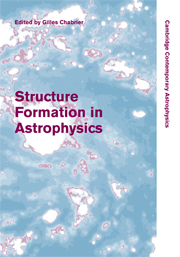Book contents
- Frontmatter
- Contents
- List of contributors
- Preface
- Part I Physical Processes and Numerical Methods Common to Structure Formations in Astrophysics
- Part II Structure and Star Formation in the Primordial Universe
- Part III Contemporary Star and Brown Dwarf Formation
- 9 Diffuse interstellar medium and the formation of molecular clouds
- 10 The formation of distributed and clustered stars in molecular clouds
- 11 The formation and evolution of prestellar cores
- 12 Models for the formation of massive stars
- Part IV Protoplanetary Disks and Planet Formation
- Part V Summary
11 - The formation and evolution of prestellar cores
Published online by Cambridge University Press: 11 August 2009
- Frontmatter
- Contents
- List of contributors
- Preface
- Part I Physical Processes and Numerical Methods Common to Structure Formations in Astrophysics
- Part II Structure and Star Formation in the Primordial Universe
- Part III Contemporary Star and Brown Dwarf Formation
- 9 Diffuse interstellar medium and the formation of molecular clouds
- 10 The formation of distributed and clustered stars in molecular clouds
- 11 The formation and evolution of prestellar cores
- 12 Models for the formation of massive stars
- Part IV Protoplanetary Disks and Planet Formation
- Part V Summary
Summary
Introduction: dense cores and the origin of the IMF
Stars form from the gravitational collapse of dense cloud cores in the molecular interstellar medium of galaxies. Studying and characterizing the properties of dense cores is thus of great interest to gain insight into the initial conditions and initial stages of the star formation process.
Our observational understanding of low-mass dense cores has made significant progress in recent years, and three broad categories of cores can now be distinguished within nearby molecular clouds, which possibly represent an evolutionary sequence: starless cores, prestellar cores and ‘Class 0’ protostellar cores. Starless cores are possibly transient concentrations of molecular gas and dust without embedded young stellar objects (YSOs), typically observed in tracers such as C18O (Onishi et al. 1998), NH3 (Jijina et al. 1999) or dust extinction (Alves et al. 2007), and which do not show evidence of infall. Prestellar cores are also starless (M* = 0) but represent a somewhat denser and more centrally concentrated population of cores which are self-gravitating, hence unlikely to be transient. They are typically detected in (sub)millimetre dust continuum emission and dense molecular gas tracers such as NH3 or N2H+ (Benson & Myers 1989; Ward-Thompson et al. 1994; Caselli et al. 2002), are often seen in absorption at mid- to far-infrared wavelengths (Bacmann et al. 2000; Alves et al. 2001) and frequently exhibit evidence of infall motions (Gregersen & Evans 2000). Conceptually, all prestellar cores are starless but only a subset of the starless cores evolve into prestellar cores; the rest are presumably ‘failed’ cores that eventually disperse and never form stars.
- Type
- Chapter
- Information
- Structure Formation in Astrophysics , pp. 254 - 287Publisher: Cambridge University PressPrint publication year: 2009
- 34
- Cited by



